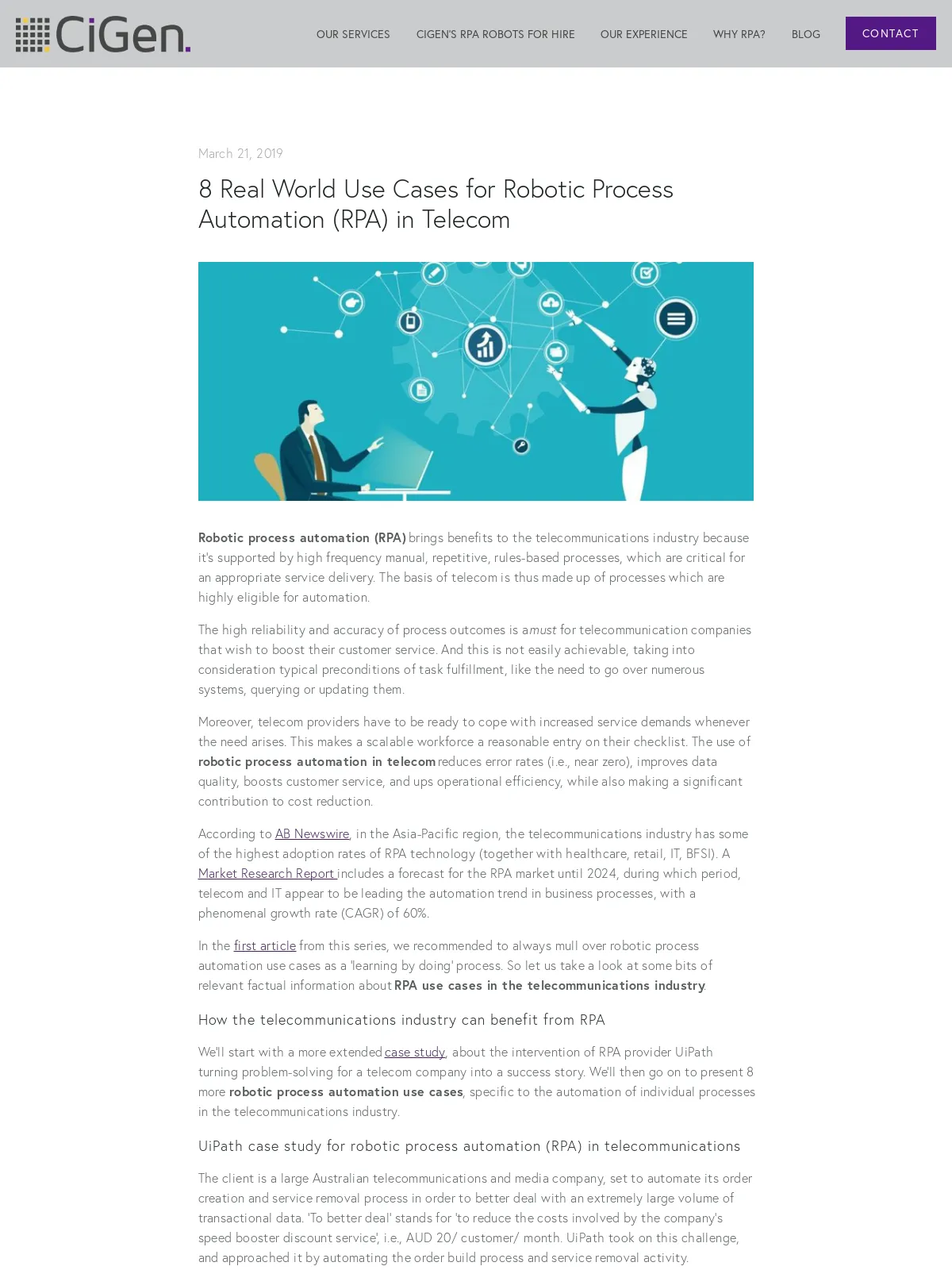8 Real World Use Cases for Robotic Process Automation (RPA) in Telecom
Blog: Cigen

Robotic process automation (RPA) brings benefits to the telecommunications industry because it’s supported by high frequency manual, repetitive, rules-based processes, which are critical for an appropriate service delivery. The basis of telecom is thus made up of processes which are highly eligible for automation.
The high reliability and accuracy of process outcomes is a must for telecommunication companies that wish to boost their customer service. And this is not easily achievable, taking into consideration typical preconditions of task fulfillment, like the need to go over numerous systems, querying or updating them.
Moreover, telecom providers have to be ready to cope with increased service demands whenever the need arises. This makes a scalable workforce a reasonable entry on their checklist. The use of robotic process automation in telecom reduces error rates (i.e., near zero), improves data quality, boosts customer service, and ups operational efficiency, while also making a significant contribution to cost reduction.
According to AB Newswire, in the Asia-Pacific region, the telecommunications industry has some of the highest adoption rates of RPA technology (together with healthcare, retail, IT, BFSI). A Market Research Report includes a forecast for the RPA market until 2024, during which period, telecom and IT appear to be leading the automation trend in business processes, with a phenomenal growth rate (CAGR) of 60%.
In the first article from this series, we recommended to always mull over robotic process automation use cases as a ‘learning by doing’ process. So let us take a look at some bits of relevant factual information about RPA use cases in the telecommunications industry.
How the telecommunications industry can benefit from RPA
We’ll start with a more extended case study, about the intervention of RPA provider UiPath turning problem-solving for a telecom company into a success story. We’ll then go on to present 8 more robotic process automation use cases, specific to the automation of individual processes in the telecommunications industry.
UiPath case study for robotic process automation (RPA) in telecommunications
The client is a large Australian telecommunications and media company, set to automate its order creation and service removal process in order to better deal with an extremely large volume of transactional data. ‘To better deal’ stands for ‘to reduce the costs involved by the company’s speed booster discount service’, i.e., AUD 20/ customer/ month. UiPath took on this challenge, and approached it by automating the order build process and service removal activity.
“Within 4 weeks, UiPath provided 4 robots, running 24/7 on the client’s CRM system, which were able to process 480-600 daily orders, and, based on these, generate daily reports to be discussed with stakeholders. In the first four months, 25.000 orders have been processed by automating 90% of transactions. The telecom company thus saved 10 FTES.”
8 use cases for robotic process automation (RPA) in telecom
1. Periodic report preparation and dissemination
The above success story about robotic process automation in telecom includes an instance of report auto-generation, too. Upon generation, the bot can also analyze the content of the report. Based on the provided criteria, it can decide which stakeholders the report is relevant to, and email it to them. The information thus flows more efficiently.
2. Responding to partner queries
Software robots are smart enough to interpret emails, respond to simple questions, and forward complex ones to humans. This is particularly useful for telecom companies, which usually rely on partners like independent brokers to sell their services.
3. Reducing manual sales order processing effort
RPA technology can capture the business process tasks performed by the employees of a telecom company. Based on employees’ actions, a well structured workflow can be generated, which serves as an infrastructure for automated processes. By mapping each process step with its associated cost for manual execution, it is easy to identify the automation of which steps leads to highest return on investment.
Those steps should be prioritised for intelligent automation, since they would also lead to the greatest reduction of manual processing effort. As a result, information flow efficiency is also improved. This application area is a good example of RPA helping to manage large, unstructured datasets.
4. Competitor price tracking
The transparency of online pricing is a strong motivator for tracking competitors’ prices, especially in the case of eCommerce. And since eCommerce is becoming the norm in telecommunications according to CNBC, careful price monitoring is a very valuable asset.
It goes without saying that automation, with its error-proofness and 24/7 capacity to work, can provide a telecom company with the most careful kind of comparative price analysis. Moreover, software robots can do the tracking at individual, category and brand level, which can offer deeper understanding of the competitive outlook.
5. Backing up information from clients’ IP telephony systems
Software robots can chain up numerous technical tasks, creating coherent backup systems. Their scope of usage is as broad as the scope of telephony systems, since backups can be done irrespective of the client’s specific system.
How does it work? The bots can obtain data from the databases of all IPT devices on a client system, and upload them onto an FTP server. Refreshes can be scheduled according to the client’s needs.
6. First Call Resolution (FCR)
This means resolving all of client’s concerns from the first call to a customer service call center, bots can assist employees by offering real-time guidance (i.e., relevant information at the right moment), based on monitoring their desktop activities.
They can automatically perform actions that bring desired tasks to completion, e.g. retrieve specific customer information, rekey data, update fields. In the meantime, the employee can focus on constructively attending customers, which is likely to diminish their level of frustration, and ultimately result in resolved cases.
7. Raising Customer Satisfaction Scores
This is a direct consequence of point 6 above. With the assistance of robotic process automation, employees can offer accurate, functional solutions in a timely fashion. Moreover, they have the capability of acting like humans, i.e. listen to problems and provide guidance towards implementing solutions, and not merely respond on autopilot.
Since this seems to be precisely what customers are looking for according to Customer satisfaction and call centers: an Australian study, it’s very probable that your Net Promoter Score goes up.
8. Average Revenue per User (ARPU)
This is another application area of attended automation in call centers. Software robots can offer real-time information during customer calls, regarding customers’ eligibility for given promotions, thereby ensuring more focused, to-the-point pitches. The upshot? Higher close rates and average deal size.
Conclusion
The above-mentioned UiPath case study showed a significant cost reduction and faster available ROI. This makes perfect sense, if we consider that in areas fit for automation, telecom full-time employees cost the company five times more than software robots.
The scalability of robotic process automation (RPA) in telecom helps more flexible adjustments to changes (both up- and downward) in customer demand or internal growth. An automated workforce is actually ‘alive’ in the sense that it can smoothly follow unavoidable modifications of the defining features of telecommunications companies. Higher levels of operational agility comes as a natural consequence.
Large volumes of data from multiple systems can be more easily managed by using interactions with user interfaces that mimic human mouse clicks and keystrokes. This ensures a streamlined information flow, which ultimately contributes to the abovementioned financial advantage.
We end by mentioning once again that this is part of a series of articles about real world use cases for RPA in different industries. If you found the information useful, please subscribe to our newsletter to make sure that you stay updated with cross-industry news about the fast-evolving intelligent automation market.
